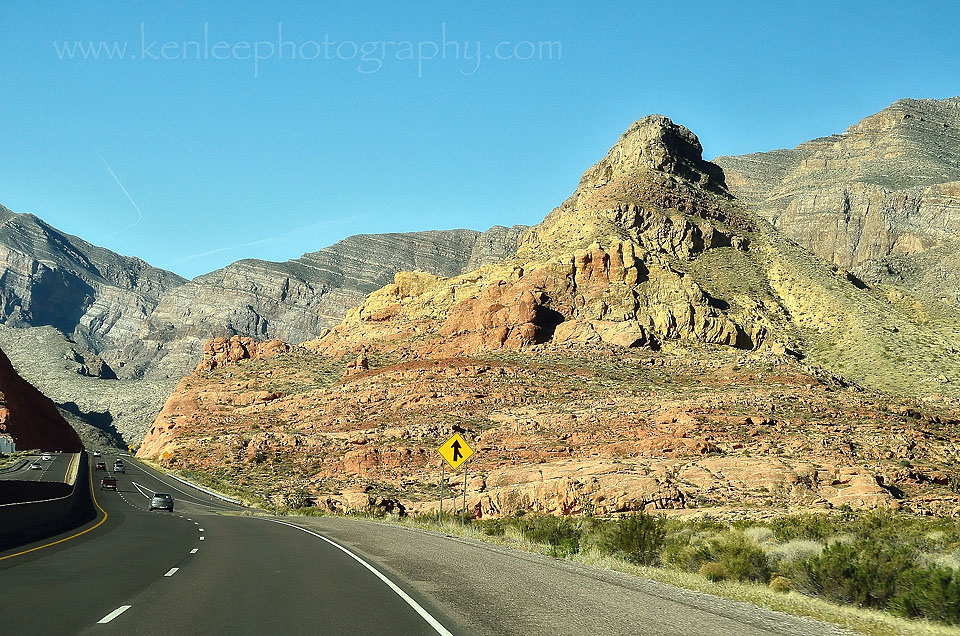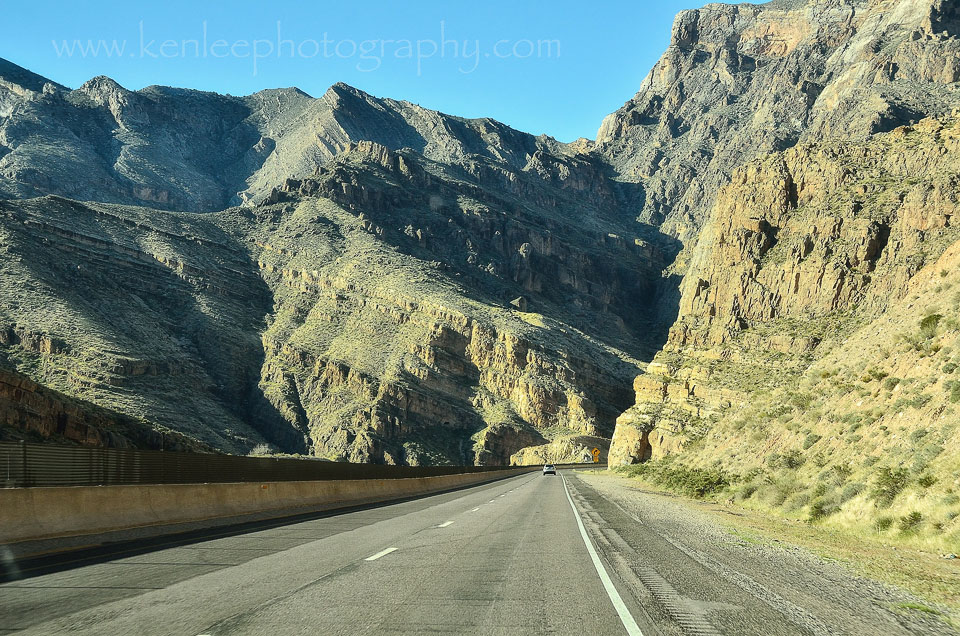
Valley Of Fire & Zion, Nevada and Utah, March 2013: Night Sky, Long Exposure, and Landscape Photos of the Parks
Page 4 of 4
For this photo, I had to move the camera a couple of times. The moon seemed to be turbo-charged, moving across the canyon sky too quickly. I moved the camera further over to the right, also a great view, and felt satisfied. I had The Organ bracketed by the Great White Thrown on the left and Angels Landing on the right, and all seemed good. I had seen another photo of this taken by a photographer, one of the Milky Way. He and his son had set up this elaborate array of strobe lights, constant incandescent lights, and dish reflectors - all in all, five lights, placed 500 to 700 feet away from the camera, with strobes set to trigger via radio command. It was quite a setup. I therefore was extremely surprised when I shined my Dorcy flashlight on the organ and found that I could actually illuminate it even though it was monstrously huge and fairly far away. And sure, while the Dorcy is a very strong flashlight, almost like holding a car headlight in your hand, it still seemed absurd that I could do this. So I took one photo relatively early on, illuminating The Organ, and then began taking the sequence of shots to stack into a star trails photo, eventually blending the two together in Photoshop. Title: Big Bend Star Trails |
I had seen another photo of this taken by a photographer, one of the Milky Way. He and his son had set up this elaborate array of strobe lights, constant incandescent lights, and dish reflectors - all in all, five lights, placed 500 to 700 feet away from the camera, with strobes set to trigger via radio command. It was quite a setup. I therefore was extremely surprised when I shined my Dorcy flashlight on the organ and found that I could actually illuminate it even though it was monstrously huge and fairly far away. And sure, while the Dorcy is a very strong flashlight, almost like holding a car headlight in your hand, it still seemed absurd that I could do this. So I took one photo relatively early on, illuminating The Organ, and then took the 20-second night sky shot, eventually blending the two together in Photoshop. Title: Evening in Big Bend And I waged battle with the infernal moon continually trying to blot out the sky and create lens flare. :D |
I asked people on my photography Facebook page and on a Long Exposure Photography Group Page. The results were interesting. On my Facebook page, approximately 1/3 of the comments preferred the one lit with the headlights vs. 2/3 for the darker, starker, moodier, colder moon-illuminated one. But the "likes" were higher for the headlight-illuminated one, although that could have been because it came first in the album, and in someone's newsfeed, they might just click "like" without realizing what was being asked. On the Long Exposure Photography Group Page, on the other hand, all but one photographer preferred the darker moon illumination. But the comments helped me crystallize what I liked about each photo. I decided I would sort of combine them. So this has a hint of the car's illumination blended in but is otherwise the moodier, starker, moon-illuminated photo, a 50 minute exposure in total. You can see the two other versions by clicking here: |
 Saturday 23 March 2013: Saturday 23 March 2013:After light painting, I returned back, and we woke up the next morning and figured we'd take some easier walks, including Weeping Rock. We were intrigued by the frozen plants. |
 Beautiful Zion. Beautiful Zion. |
We ate at the extremely popular Oscar's Cafe. While waiting, I purchased a T-shirt colored in dyed from red sandstone dirt. Yes. The stuff doesn't come out, so my shirt would have its color for a while. Then, finally after a wait, we devoured our hamburgers, me eating the Whoop-Ass Burger, which they touted as being very spicy, with "jalapenos" and later on, "more jalapenos". But while it was flavorful and had a bit of heat, it was hardly a spicy burger despite the silly name. The outdoor heating lamps were welcome, as it was cold and windy, with the temperature dropping from a high of 63 F to much colder rather rapidly since the sun had set. |
On the way out of the Bumbleberry Inn, we saw this fun early morning scene, sprinklers seemingly spraying ice on an icy lawn and icy trees.
|
 And the icy plants weren't just a thing from the Bumbleberry Inn, either, since we saw this fantastically icy vineyard on our way out of Springdale. And the icy plants weren't just a thing from the Bumbleberry Inn, either, since we saw this fantastically icy vineyard on our way out of Springdale. |
 I rarely take photos from a moving car, but I wanted to share a couple of photos of how beautiful the small slice of Arizona is that we drove through on Interstate 15. I rarely take photos from a moving car, but I wanted to share a couple of photos of how beautiful the small slice of Arizona is that we drove through on Interstate 15. |
 Another amazing canyon scene in the small slice of Arizona that we drive through between Utah and Nevada on Interstate 15. Another amazing canyon scene in the small slice of Arizona that we drive through between Utah and Nevada on Interstate 15. |
But here, he stared me down, insisting that we eat at the Mad Greek Cafe in Baker again. And we typically do George's bidding, that's what Lisa and I did, once we got past the giant parking lot they call Interstate 15 by Primm in Nevada. |
"It's not just a silly name for a road, there's this whole history behind it, you see. The made-up name Zzyzx was given to the area in 1944 by Curtis Howe Springer, claiming it to be the last word in the English language. He established the Zzyzx Mineral Springs and Health Spa in 1944 at the spot after filing mining claims for 12,000 acres (49 km2) surrounding the springs. He used the springs to bottle his water and provide drinks for travelers through the hot desert." Lisa and I nodded our heads in amazement as George continued. "There was also a film made around here, 'Zzyzx Road'. It has the distinction of being considered one of the lowest grossing movies in history with a domestic gross of $30.00 USD. It was originally released in just one theater, rented by the producers for $1000. The limited release was deliberate because the filmmaker was uninterested in releasing the film domestically until it underwent foreign distribution, but needed to fulfill the U.S. release obligation required by the Screen Actors Guild for low-budget films (films with budgets less than $2.5 million that are not for the direct-to-video market). The strategy had the side effect of making the film at the time the lowest-grossing film of all time, earning just $30 at the box office from six patrons...but unofficially was worse than that since they reimbursed the makeup artist $10." George, as usual, was a fountain of information. |
. Title: Our Celestial Blanket Light painting in the dark has its hazards. I've bashed my foot into cacti and tripped over rocks. For this shot, I scratched up both hands light painting this, running into the long branch of a thorny bush. After I finished this photo, I looked down and saw both my hands covered in blood. |
Title: Arch Rock Star Trails |
|
Ken's photos of Nobel Peace Prize Winner Aung
San Suu Kyi, as well as photos of Peru, Burma, India, Morocco, China, Thailand,
Ghana, Ecuador, and elsewhere, have appeared in many books, magazines,
websites, and galleries. Visit the
Ken Lee Photography Website. Some of Ken's select photos may be
purchased through his
Imagekind Store. Join the fun and participation on Ken's Facebook Page. |
Valley of Fire State Park, Zion National Park, Nevada and Utah, March 2013
Page 4 of 4
Eleven Shadows Travel Page
Contact photographer/musician Ken Lee